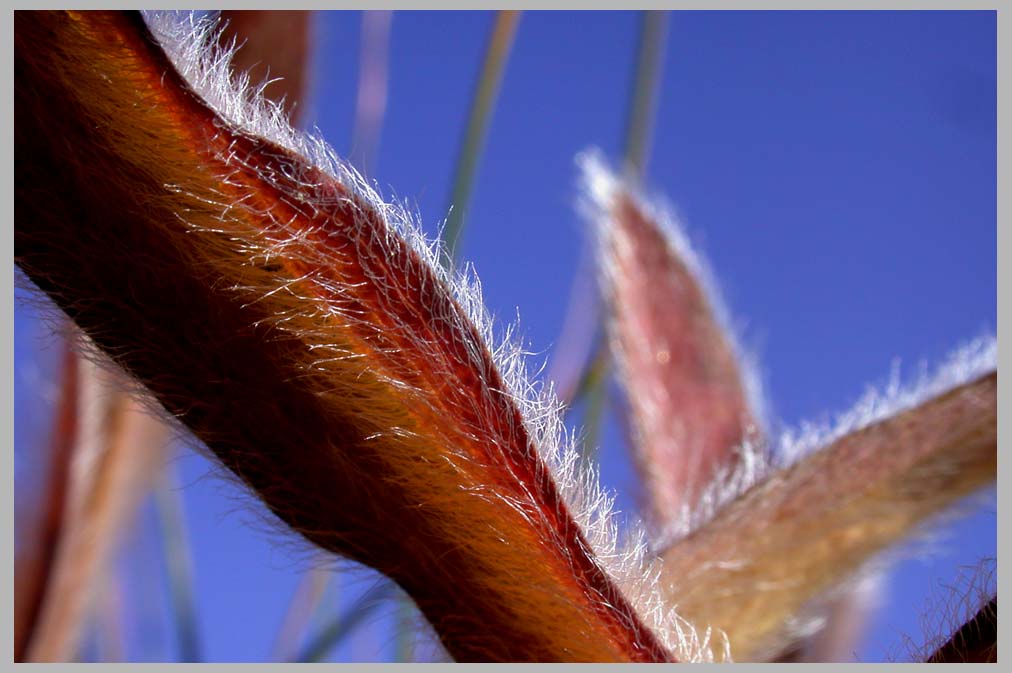
Western Hawkweed Leaves—close-up IX.15.08 (Hieracium albertinum)
Member of the Aster family.

Western Hawkweed Leaves—close-up IX.15.08 (Hieracium albertinum)
Member of the Aster family.
Hawkweed is a perennial which is densely pubescent with long white hairs
and a milky sap found in the entire plant. According to Charles Johnson,
Hawkweed was used as a source of chewing gum by Native Americans.
Eagle Cap Wilderness . . .
Close-up photography is for me a kind of meditation
on form. A meditation on structure, on how the normally
not clearly visible parts of especially the wonderful
world of plants fit and work together.
In my dumbstruck, simplistic way, I find myself
frequently saying aloud,"Why isn't this enough?"
Why isn't this revelation of Nature's beauty not
enough to turn us all into humble and devoted monks,
scientists and artists?
This is what I think of as the mystery of the middle
realm. The central image of this middle realm——a space
residing between the incomprehensibly small and
the incomprehensibly large——is for me a three-fold
composite: the branching structures of a tree, a river,
and a fundamental tone with its overtones. I'll come back
to this idea in another miniature, but for now, just
let me say that I believe that we——despite the great
and wonderful achievements of Western science——do not
understand this middle realm very well. Why do I say this?
Well, because it is in a self-evident, obvious way,
demonstrated in the short-comings of what we make and
design.
Take one of my recurrent themes: the imposition of
the straight-line grid of force that car-culture
designers overwhelming seem to prefer. (If there
are anywhere exceptions in North American to this
rule, the burden of proof is on you.) In the Northwest,
the rectilinear pattern dominates all, resulting in
a strident 'wolftone' or contradiction with the
immense beauty and spirit of the land itself.
Indeed, I might have expanded the phrase had the measure
allowed in the last little piece below to: "In the West,
Cut down. Dig up. Pave straight roads.
Put barbed-wire around the rest."
Here then is a little set of three 37-step poems*
which plays with this theme of the unfortunate misfit
between natural and cultural structures.
The "man of one cup" is in this case me.
This is really true; that is how I live.
I long ago embraced and took my vows with Lady Poverty.
This, I find liberating. I periodically go down into
the low country to pay my bills, get provisions, see
friends, and do my necessary web work, etc. But each
time I return to the mountains, I say,"Ah, the end
of survival, and the
beginning of living."
And one of the first things I invariably do is go
to a fast, clear-running stream, and wash and
fill my cup.
MAN OF ONE CUP
(I)
Empty, round metal
cup I use every day, how I've
grown fond of the feel in my hand,
center with
gifts from far and near.
Hot teas steeped in cold spring water.
(II)
Square grid without a
center, towns built with quick money,
with gold, whiskey, easy women.
Home was
always someplace else.
O Silver Maple, so far West.
(III)
Boom days of easy
plunder now a thing of the past,
Speed's run flat dead knowing that the
direction
was wrong. Cut down. Dig
up. Put barbed-wire around the rest.
Camp Lost & Found,
Eagle Cap Wilderness,
Oregon, IX.15.2008
THE LITTLE CLAVIER please preview
150 of 631 pages
w/ my black & white photography
[opens in new window]
*In order for a variation form like this to really flower, one needs to do
them in sets or sequences. Try reading them out-loud to get a sense of
how the rhythms and accents change in surprising ways while still keeping
to the basic 37-step pattern.
All Photographs & texts by Cliff Crego © 2011 picture-poems.com
(created: X.11.2008)